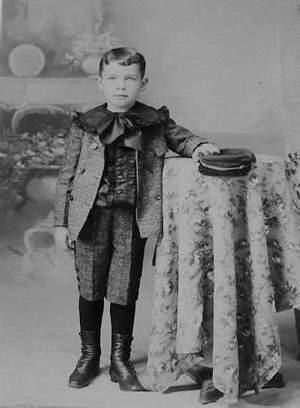
Figure 10.--This Amerocan boy is wearing a kneepsnts suit with a dark Fauntleroy blouse. The jacker was made to be worn open to show off the blouse. /i> |

Developing a chronolgy of boys' shirts is a little complicated, especially for the 19th century. Our archive of images is very limited, especially for the early-19th century before the development of photography. This is also in part because boys generally wore jackets, As a result, it is often not possible to see the shirts that they are wearing, even if images are available. We note boys wearing both blouses and shirts in the 19th century. Often all we can see is the collar and sometimes the sleeve cuff. We note large collars in the early 19th century. Some were worn closed and others open. The Eton collar, we think in the early-19th century. Bitton-on shorts seem very common at mid-century. appeared in England and eventually became a major style. Boys seem to have worn plain shirts for dress occasions during the mid-19th century. A variety of shirts were worn. Plaid seems to have been popular. Most mothers, however, insisted on adding a white collar and bow. We are not always able to destinguish between shirts and blouses. The development of the detachable collar mean that increasing attention was paid to collars. At mid-century these collars and bows were quite small. Occassionally we see slightly larger collars. An example is an unidentified American boy. We see shirts made in heavy material and worn rather like a jacket. Later in the century they got much larger. This was when fancy Fauntleroy blouses became popular. The sailor blouse also became widely popular. It was still not common to dress up without a suit jacket--except during the summer when fancy blouses could be worn. Blouses with large collars became popular in the late-19th century.
Developing a chronolgy of boys' shirts is a little complicated, especially for the 19th century. Our archive of images is very limited, especially for the early-19th century before the development of photography. This is also in part because boys generally wore jackets, As a result, it is often not possible to see the shirts that they are wearing, even if images are available. We note boys wearing both blouses and shirts in the 19th century. Often all we can see is the collar and sometimes the sleeve cuff. We note large collars in the early 19th century. Some were worn closed and others open.
The Eton collar, we think in the early-19th century. Button-on shirts seem very common common at mid-century. We note them in the 1840s, but they presumably appeared even earlier. The Eton collar first appeared in England and eventually became a major style.
Boys seem to have worn plain shirts for dress occasions during the mid-19th century. A variety of shirts were worn. Plaid seems to have been popular. Most mothers, however, insisted on adding a white collar and bow. We are not always able to destinguish between shirts and blouses. The development of the detachable collar mean that increasing attention was paid to collars. At mid-century these collars and bows were quite small. Occassionally we see slightly larger collars. An example is an unidentified American boy.
We see both solid-colored and patterned shirys in the 1860s. It is difficult to destinguish shirt and blouses. Collsrs tenmd to be small or non-existent. Younger boys commonly wore button-on shirts whichb held up their pants. Cut-away jackets were popular in the 1860s which allowes us to see the shirts better thsmn other types of suit jackets. A good example are two unidentified American boys.
We see shirts made in heavy material and worn rather like a jacket. Later in the century they got much larger. This was when fancy Fauntleroy blouses became popular. The sailor blouse also became widely popular. It was still not common to dress up without a suit jacket--except during the summer when fancy blouses could be worn.
|
The Fauntleroy craze had a major impact on the 1890s. Blouses with large collars became popular in the late-19th century. We see boys of all ages wearing them, including younger teenagers. Some were very fancy and made out of expensive materials. The unidentified boy here is a good example (figure 1). They were also made in plsiner materials. We also notice Eton collars.
Navigate the Historic Boys' Clothing Web Site:
[Return to the Main shirt chronology page]
[Return to the Main shirt page]
[Introduction]
[Activities]
[Biographies]
[Chronology]
[Clothing styles]
[Countries]
[Bibliographies]
[Contributions]
[Essays]
[FAQs]
[Glossaries]
[Images]
[Links]
[Registration]
[Tools]
[Boys' Clothing Home]
Navigate the Historic Boys' Clothing Web chronological pages:
[The 1840s]
[The 1870s]
[The 1880s]
[The 1890s]
[The 1900s]
[The 1910s]
[The 1920s]
[The 1930s]
[The 1940s]
Navigate the Historic Boys' Clothing Web sailor pages:
[Main sailor suit page]
[Reefer jackets]
[Middy blouses]
[Sailor dresses]
[Other sailor styles]
[Sailor hats]
[The Royals]
[Ring bearer/page costumes]
